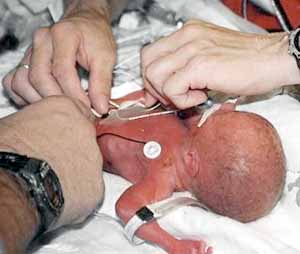Springfield, IL (Nov. 23, 2010) — November is Prematurity Awareness Month, dedicated by activists to highlighting the risks of and impact created by preterm birth.
According to the March of Dimes, more than half a million babies are born prematurely in the United States alone each year. Yet most people — including women at risk of abortion and their loved ones — are unaware that abortion has been linked to an increased risk of preterm birth among subsequently born babies.
 In a paper published in the British Journal of Obstetrics and Gynaecology in 2009, a Canadian research team examined data from 37 studies and found that having a prior abortion increased the risk of subsequent preterm birth by 35 percent, while having more than one prior abortion increased the risk by 93 percent.1 (Preterm birth is defined as a birth that takes place before 37 weeks gestation.)
In a paper published in the British Journal of Obstetrics and Gynaecology in 2009, a Canadian research team examined data from 37 studies and found that having a prior abortion increased the risk of subsequent preterm birth by 35 percent, while having more than one prior abortion increased the risk by 93 percent.1 (Preterm birth is defined as a birth that takes place before 37 weeks gestation.)In other words, children whose mothers had a previous abortion were more likely to be born prematurely, putting them at greater risk for problems such as low-birth weight (which has been linked to physical and developmental problems), epilepsy, autism, mental retardation2 and cerebral palsy. A research team looking at data from 2002 estimated that prior abortions led to 1,096 cases of cerebral palsy among babies born prematurely that year.3
There are risks to the mother with preterm birth as well, as other studies have found that women who give birth at less than 32 weeks double their lifetime risk of breast cancer.4
Evidence linking abortion and preterm birth continues to pile up, researchers and advocates say. Another paper published in 2009 found that found that having a previous abortion raised a woman’s relative odds of having a subsequent birth at less than 32 weeks by 64 percent.5
Further, as far back as 2006 the Institute of Medicine included “prior first trimester abortion” on a list of risk factors associated with premature birth.6 However, as Brent Rooney, Director of Research for the Reduce Preterm Birth Coalition, has pointed out, abortions continue to be performed despite the strong evidence of risks—and in the absence of any evidence showing the procedure to be harmless.
“In the ‘Court of Medicine’ a ‘defendant’ new surgery or new drug is presumed guilty of serious adverse side effects until by strong evidence it is demonstrated to be innocent,” Rooney noted. Yet 50 years after the development of the suction abortion procedure, he said, there has never been a “‘study of studies’ or systematic review” that has proven that abortion does not cause premature birth. Instead, the evidence seems to be pointing in the opposite direction.
And even as the evidence linking abortion and preterm birth continues to pile up, women and their loved ones are not being told of the risks. The result is that women and girls will end up undergoing abortions without having the information needed to make a decision–which is a form of coercion. And it puts the mothers, their unborn children and any future children they may have at risk.
~~~
Learn more: Access the world’s most extensive online library of studies on the physical and psychological effects of abortion at www.AbortionRisks.org.
Share More: Download and share our Recent Research Fact Sheet with others.
1. P.S. Shah and J. Zao, “Induced termination of pregnancy and low birthweight and preterm birth: a systematic review and meta-analysis,” BJOG 116(11): 1425-1442 (2009).
2. Barbara Kay, “The abortion issue we’re ignoring,” National Post, June 10, 2009.
3. B.C. Calhoun, E. Shadigan and B. Rooney, “Cost Consequences of Induced Abortion as an Attributable Risk for Preterm Brith and Informed Consent,” Journal of Reproductive Medicine 52(10): 929-937 (2007).
4. M. Melbye et. al., “Preterm Delivery and risk of breast cancer,” British Journal of Cancer, 80(3-4): 609-613 (1999); and K.E. Innes and T.E. Byers, “First pregnancy characteristics and subsequent breast cancer risk among young women,” International Journal of Cancer, 112(2): 306-311 (2004).
5. H.M. Swingle et. al., ” Abortion and the Risk of Subsequent Preterm Birth: A Systematic Review and Meta-Analysis,” Journal of Reproductive Medicine 54:95-108 (2009).
6. R.E. Behrman et. al., Preterm Birth: Causes, Consequences and Prevention (Washington, D.C., National Academies Press, 2007).
